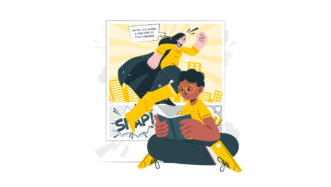LESSON OVERVIEW
The main objectives of this advanced lesson about branding are to:
- talk about consumer behaviour and brand-building strategies;
- watch a video and discuss what experts say about branding;
- practise vocabulary to talk about the topic.
With this lesson, students talk about branding and give their opinions on brand-building strategies. They watch an explainer video about branding, discuss the relationship between consumers and brands, read a text about a rising phenomenon among consumers and explore vocabulary related to branding.
C2 / Proficiency60 minStandard LessonFree
WARM-UP AND VIDEO
This advanced lesson about branding starts with a warm-up where students read a quote about the topic, explain what they think it means and say to what extent they agree with it. After that, they discuss questions about the brands that first come to mind when they think of some items (e.g. a soda, a laptop, sunglasses, etc.) and their loyalty as customers. Afterwards, students watch the first part of a video in which experts talk about branding. Before they do, students read a quote from the video and choose the option they think completes it. Then, they watch the video and check their answer. Next, students watch the rest of the video and check their listening comprehension by taking notes on specific topics (e.g. what brands are compared to and why).
DISCUSSION AND VOCABULARY
In this part of this advanced lesson about branding, students discuss statements and ideas about the connection between consumers and brands and say to what extent they agree with them. After that, they match sentence beginnings and endings to complete brand-building strategies (e.g. align with social values by contributing to positive change in the world). Then, students read the statements again and say which strategies contribute most to a brand’s success. They also give examples by considering popular brands. Afterwards, students brainstorm what the alone-together paradox, a phenomenon among consumers, might be. Then, they read a text about the topic and check their ideas. Following that, students read the text again and complete the gaps with the correct form of words (e.g. align, forge, niche, etc.). Finally, they complete statements about consumer behaviour and brand adaptation with their own ideas. They share them with a partner and see if they agree.
HOMEWORK/REVISION
This lesson also includes an additional task that you can use as homework or revision. In the task, students read the definition of brand archetypes and statements about how popular brands adopt them. They replace words with the target vocabulary and finish the sentences with their own ideas. The task is available in the teacher’s version of the worksheet. You can print it and hand it out to your students. It’s also included in the e-lesson plan.
WORKSHEETS














This is the best lesson plan yet! Thoroughly enjoyed it.
Thanks for your comment! Great to hear that you enjoyed it 😀
This activity can be used in conjunction with preparing for the Toeic exam?
Hi! In this lesson, students discuss brand-building strategies and work with vocabulary related to the topic. While it isn’t specifically designed for TOEIC preparation, I believe it could be helpful for students preparing for a business-oriented exam like TOEIC.
Hi guys, just wanted to say how nice the plan is in terms of engaging video and great vocabulary set. However, one my students who is a brand strategist pointed out the mistaken identification of brand archetypes (starting from Apple, through Starbucks etc). Please take another look at the examples. 🙂
Hi! Thank you so much for your feedback. Thrilled to hear that you and your students have found the lesson engaging! We also appreciate your student’s feedback on the brand archetypes task – it’s great to see how involved they were in the lesson 🙂
Based on the research we did in order to create this lesson, we understand that one brand can actually fit into multiple categories. So, Apple, for example, isn’t just a Sage archetype; it also shows traits of the Creator and the Magician archetypes. You can check out more about how Apple reflects the Sage archetype here, or how Starbucks is considered to be the Caregiver Archetype here.
Hope this helps! If you have any more thoughts or suggestions, please feel free to share them! Thanks again!
Thanks for your response and the sources – another opportunity to use it in class 🙂
This is a great lesson! I love it! Super enriching and engaging. I have a C2 business class and this lesson is perfect for it! Thanks!!!
Thank you so much! It’s great to hear that it’s a good fit for your C2 business class!
I had hoped it would be another take on the lesson that Fluentize had already offered, but I see even the video is the same. Nevertheless, it’s a solid lesson plan.
Thank you for your feedback! I’m sure branding is a common theme in lesson creation, but it can certainly be explored from various angles. I’m pleased to hear that you found the lesson plan solid!
Absolutely brilliant lesson! Thank you so much 🙂
So happy to hear that! Thank you for the comment! 🙂